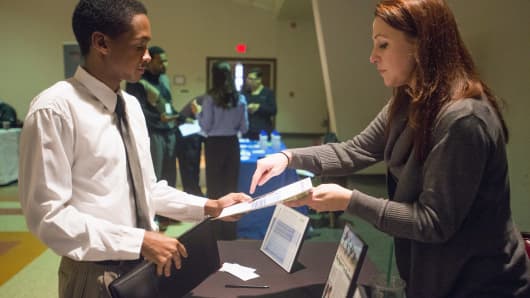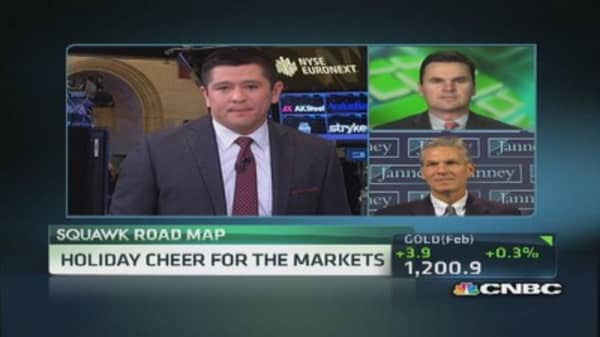Overall, the economy grew at a surprisingly strong 4.1 percent annual rate in the third quarter—the best showing in over a year.
"There is confidence that there is strength in underlying demand," said Ira Kalish, chief global economist for Deloitte Touche Tohmatsu. "If we see more investment and more hiring by small businesses it could have a very positive impact—because small businesses historically account for the lion's share of job growth. And that's where we haven't seen strong job growth."
That sluggish job growth goes a long way to explaining why—for millions of Americans—the Great Recession never ended. While the "official" unemployment rate has fallen steadily since the summer of 2009, the improvement in the data has come largely from the ongoing wave of jobless people who have given up looking for work.
(Read more: Bad news on jobs front: Claims spike to fresh high)
Many of them—like Mary Villalba, 65, of Centennial, Colo.—fear they may never find a job as good as the one they lost to the recession.
Since getting laid off at a mortgage company in 2007, she's done consulting and taken part-time jobs. Though still looking for full-time work, she says she's growing resigned to being underemployed.
"It's hard not to be discouraged when I compare my credentials against those of people 40 years my junior who get the job offers," she said.
Business has also been slow this year for her husband of 25 years who works for a commercial roofing company. Villalba figures their household income, which peaked around $125,000 a year before the recession, has fallen roughly in half. She doubts it will ever get back to prerecession levels. The couple's retirement savings went to pay college tuition for their three now-grown daughters. Lately she's taken on part-time work handling title closings.
"The hours can be very long and erratic and there is no steady paycheck, but it at least helps pay some of the bills," she said. The couple has cut back on dining out and groceries, and she no longer goes clothes shopping.
For millions of underemployed workers like Villalba, the bills are much harder to keep up with than they were before the Great Recession.
The belt-tightening has cut into sales at many businesses, including Balliets, a high-end women's clothing store in Oklahoma City. Owner Bob Benham said this year's sales were flat compared to last year.
Now, after a successful store expansion in 2010, Benham has shelved plans to open a new store, because his "gut feeling is: Sit tight."
"There is a lot of waiting-and-seeing both with consumers and small retailers," he said. "And I just think there are a number of anchors creating a less-than-exuberant feeling for both of them."
Those anchors include key forces that typically help propel an economy out of a downturn.
While the housing market has perked up in the past two years, for example, new construction and existing home sales are still below prerecession levels. Credit has begun easing, but mortgages are still hard to get. And ultra-low mortgage rates have begun moving higher this year.
Home prices, meanwhile, are still well below 2006 peak levels in many parts of the country, leaving more than 10 million owners who bought at the peak owing more than their home is worth.
That lost home equity helps explain why the "wealth effect" of rising housing and stock markets, which typically spurs further economic growth, has been so muted in the recovery.
This recovery has further concentrated that dual wealth boost among the richest Americans. Because those at the top of the wealth ladder typically spend a smaller share of their income than those in middle- and lower- income households, the concentration has further dampened overall consumer spending.





